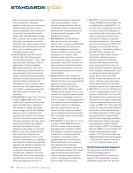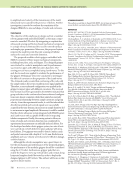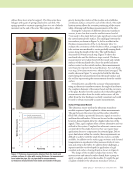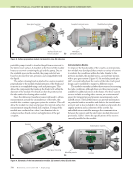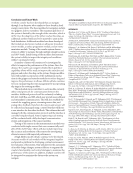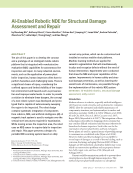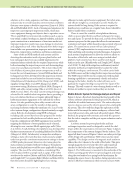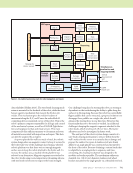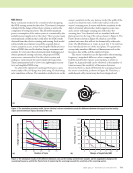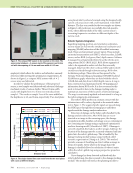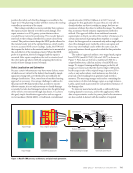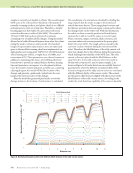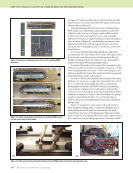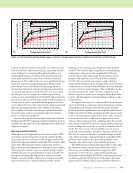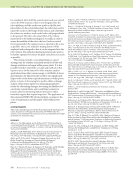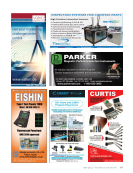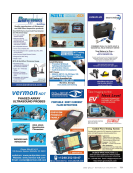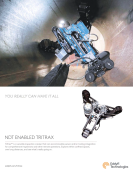726 M A T E R I A L S E V A L U A T I O N • J U L Y 2 0 2 1 in amplitude and velocity of the transmission of the Lamb ultrasound waves caused by the presence of defects. Further investigation is needed to evaluate the sensitivity of the designed EMATs to size and shape of cracks and corrosion. Conclusion The objective of this study was to design and test a modular robotic gripper with embedded EMATs as the main compo- nent of a versatile LTI robot. By integrating a couplant-free ultrasound sensing and friction-based mechanical component in a single robot, it eliminated the need for smooth surfaces and simple pipe geometries. Moreover, the proposed system removes the need for point-by-point scanning of tubular surfaces for crack and corrosion detection. The proposed modular robotic gripper embedded with EMATs consisted of three major mechanical components, including base plate, arch, and fingers. The designed gripper was attached to a robotic manipulator and its performance was tested on pipes with different outer diameters. The sensing process was accomplished using Lamb waves. To this end, the S0 mode was applied to evaluate the performance of the gripper. Preliminary tests were conducted to investigate the effect of curvature on the properties of the Lamb waves. The obtained results revealed that conforming of the coils with the sample surface did not necessarily increase signal amplitude. Therefore, a nonconformed configuration was applied in the gripper to inspect pipes with different curvatures. The received time-domain waveform generated by the EMATs indicated that group velocities in the conformed and nonconformed configura- tions were almost consistent, while there existed an inversely proportional relationship between sample curvature and group velocity. From the experimental results, it could be inferred that directly transmitted and received signals were successfully acquired in the time domain. An increase in sample diameter led to an increase in signal amplitude. Moreover, it could be verified that the robotic ultrasonic system integrated with EMATs gener- ated Lamb waves with acceptable SNR levels for inspecting tubular components. Finally, the sensing system’s efficacy in terms of cracks and corrosion detection was considered via experimental measurements on artificially induced defects. For the developed modular robotic gripper system, two sets of tests were carried out on both defect-free pipes and pipe with simu- lated defects. Two grippers were used to detect a surface crack and partial corrosion with a depth of 1 ± 0.1 mm. Reduction in amplitude and wave velocity were shown to be effective damage- sensitive features. Although the robotic manipulator was a good choice to test the mechanism and performance of the proposed gripper, the performance of the modular gripper should be considered using the LTI robot. Furthermore, gripper pads that can enable the fingers to move up vertical tubes and not just along horizontal samples should be tested in order to deploy the designed gripper in LTI robots. The authors will focus on this aspect in future studies. ACKNOWLEDGMENTS The authors would like to thank DOE-NETL for its financial support. This research effort was funded under Award No. DE-FE0031649. REFERENCES ASTM, 2017, ASTM-E1774-96: Standard Guide for Electromagnetic Acoustic Transducers (EMATs), ASTM International, West Conshohocken, PA, https:/doi.org/10.1520/E1774-17 Chattopadhyay, P., S. Ghoshal, A. Majumder, and H. Dikshit, 2018, “Loco- motion Methods of Pipe Climbing Robots: A Review,” Journal of Engi- neering Science and Technology Review, Vol. 11, No. 4, pp. 154–165, https://doi.org/10.25103/jestr.114.20 Choi, S., H. Cho, and C.J. Lissenden, 2017, “Selection of Shear Horizontal Wave Transducers for Robotic Nondestructive Inspection in Harsh Envi- ronments,” Sensors, Vol. 17, No. 1, https://doi.org/10.3390/s17010005 Choi, S., H. Cho, M.S. Lindsey, and C.J. Lissenden, 2018, “Electromagnetic Acoustic Transducers for Robotic Nondestructive Inspection in Harsh Environments,” Sensors, Vol. 18, No. 1, https://doi.org/10.3390 /s18010193 Green, Jr., R.E., 2004, “Non-contact Ultrasonic Techniques,” Ultrasonics, Vol. 42, Nos. 1–9, pp. 9–16, https://doi.org/10.1016/j.ultras.2004.01.101 Kawasaki, H., S. Murakami, H. Kachi, and S. Ueki, 2008, “Novel Climbing Method of Pruning Robot,” 2008 SICE Annual Conference, pp. 160–163, https://doi.org/10.1109/SICE.2008.4654641 Kim, J.-H., J.-C. Lee, and Y.-R. Choi, 2018, “PiROB: Vision-Based Pipe-Climbing Robot for Spray-Pipe Inspection in Nuclear Plants,” International Journal of Advanced Robotic Systems, Vol. 15, No. 6, https://doi.org/10.1177/1729881418817974 Kundu, T., 2004, Ultrasonic Nondestructive Evaluation: Engineering and Biological Material Characterization, CRC Press Kwon, Y.-S., and B.-J. Yi, 2012, “Design and Motion Planning of a Two-Module Collaborative Indoor Pipeline Inspection Robot,” IEEE Transactions on Robotics, Vol. 28, No. 3, pp. 681–696, https://doi.org/10.1109/TRO.2012.2183049 Lee, J.-H., S. Han, J. Ahn, D.-H. Kim, and H. Moon, 2014, “Two-Module Robotic Pipe Inspection System with EMATs,” Smart Structures and Systems, Vol. 13, No. 6, pp. 1041–1063, https://doi.org/10.12989 /sss.2014.13.6.1041 Lee, S.H., 2013, “Design of the Out-Pipe Type Pipe Climbing Robot,” International Journal of Precision Engineering and Manufacturing, Vol. 14, pp. 1559–1563, https://doi.org/10.1007/s12541-013-0210-z Li, D., 2017, “Machine Design of Robot for Detecting Oil Pipeline,” Chemical Engineering Transactions, Vol. 62, pp. 691–696, https://doi.org/10.3303/CET1762116 Li, J., and J.L. Rose, 2006, “Natural Beam Focusing of Non-Axisymmetric Guided Waves in Large-Diameter Pipes,” Ultrasonics, Vol. 44, No. 1, pp. 35–45, https://doi.org/10.1016/j.ultras.2005.07.002 Lissenden, C.J., S. Choi, H. Cho, A. Motta, K. Hartig, X. Xiao, S. Le Berre, S. Brennan, K. Reichard, R. Leary, B. McNelly, and I. Jovanovic, 2017, “Toward Robotic Inspection of Dry Storage Casks for Spent Nuclear Fuel,” Journal of Pressure Vessel Technology, Vol. 139, No. 3, https://doi.org /10.1115/1.4035788 Liu, Z., and Y. Kleiner, 2013, “State of the Art Review of Inspection Tech- nologies for Condition Assessment of Water Pipes,” Measurement, Vol. 46, No. 1, pp. 1–15, https://doi.org/10.1016/j.measurement.2012.05.032 Ma, R.R., L.U. Odhner, and A.M. Dollar, 2013, “A Modular, Open-Source 3D Printed Underactuated Hand,” 2013 IEEE International Conference on Robotics and Automation, pp. 2737–2743, https://doi.org/10.1109 /ICRA.2013.6630954 Marvi, H., E. Dehghan-Niri, and M. Ilami, 2020, Systems and Methods for Robotic Sensing, Repair and Inspection, US Patent Application No. 16/844,519 (pending), filed 9 April 2020 Mirkhani, K., C. Chaggares, C. Masterson, M. Jastrzebski, T. Dusatko, A. Sinclair, R.J. Shapoorabadi, A. Konrad, and M. Papini, 2004, “Optimal Design of EMAT Transmitters,” NDT & E International, Vol. 37, No. 3, pp. 181–193, https://doi.org/10.1016/j.ndteint.2003.09.005 ME TECHNICAL PAPER w modular robotic gripper for tubular components
J U L Y 2 0 2 1 • M A T E R I A L S E V A L U A T I O N 727 Park, S., H.D. Jeong, and Z.S. Lim, 2002, “Development of Mobile Robot Systems for Automatic Diagnosis of Boiler Tubes in Fossil Power Plants and Large Size Pipelines,” IEEE/RSJ International Conference on Intelligent Robots and Systems, Vol. 2, pp. 1880–1885, https://doi.org/10.1109 /IRDS.2002.1044030 Pei, C., T. Liu, H. Chen, and Z. Chen, 2018, “Inspection of Delamination Defect in First Wall with a Flexible EMAT-Scanning System,” Fusion Engi- neering and Design, Vol. 136, pt. A, pp. 549–553, https://doi.org/10.1016 /j.fusengdes.2018.03.018 Pierce, A.D., and H.-G. Kil, 1990, “Elastic Wave Propagation from Point Excitations on Thin-Walled Cylindrical Shells,” Journal of Vibration and Acoustics, Vol. 112, No. 3, pp. 399–406, https://doi.org/10.1115 /1.2930524 Qiao, J., J. Shang, and A. Goldenberg, 2013, “Development of Inchworm In-Pipe Robot Based on Self-Locking Mechanism,” IEEE/ASME Transac- tions on Mechatronics, Vol. 18, No. 2, pp. 799–806, https://doi.org /10.1109/TMECH.2012.2184294 Ren, B., H. Cho, and C.J. Lissenden, 2017, “A Guided Wave Sensor Enabling Simultaneous Wavenumber-Frequency Analysis for Both Lamb and Shear-Horizontal Waves,” Sensors (Basel), Vol. 17, No. 3, https://doi.org/10.3390/s17030488 Roh, S., and H.R. Choi, 2005, “Differential-Drive In-Pipe Robot for Moving Inside Urban Gas Pipelines,” IEEE Transactions on Robotics, Vol. 21, No. 1, pp. 1–17, https://doi.org/10.1109/TRO.2004.838000 Roh, S., D.W. Kim, J.-S. Lee, H. Moon, and H.R. Choi, 2009, “In-Pipe Robot Based on Selective Drive Mechanism,” International Journal of Control, Automation and Systems, Vol. 7, pp. 105–112, https://doi.org/10.1007/s12555-009-0113-z Rose, J.L., 2014, Ultrasonic Guided Waves in Solid Media, Cambridge University Press, https://doi.org/10.1017/CBO9781107273610 Salzburger, H.-J., F. Niese, and G. Dobmann, 2012, “EMAT Pipe Inspec- tion with Guided Waves,” Welding in the World, Vol. 56, pp. 35–43, https://doi.org/10.1007/BF03321348 Tavakoli, M., A. Marjovi, L. Marques, and A.T. de Almeida, 2008, “3DCLIMBER: A Climbing Robot for Inspection of 3D Human Made Structures,” 2008 IEEE/RSJ International Conference on Intelligent Robots and Systems, pp. 4130–4135, https://doi.org/10.1109/IROS.2008 .4651024 Xu, F., and X. Wang, 2008, “A Wheel-Based Cable Climbing Robot with Descending Speed Restriction,” 2008 Chinese Control and Decision Conference, pp. 1570–1575, https://doi.org/10.1109/CCDC .2008.4597581
ASNT grants non-exclusive, non-transferable license of this material to . All rights reserved. © ASNT 2025. To report unauthorized use, contact: customersupport@asnt.org



























































